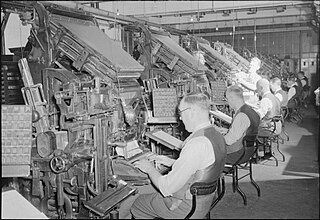
The Times is a British daily national newspaper based in London. It began in 1785 under the title The Daily Universal Register, adopting its current name on 1 January 1788. The Times and its sister paper The Sunday Times are published by Times Newspapers, since 1981 a subsidiary of News UK, in turn wholly owned by News Corp. The Times and The Sunday Times, which do not share editorial staff, were founded independently and have had common ownership only since 1966. In general, the political position of The Times is considered to be centre-right.

The history of British newspapers dates to the 17th century with the emergence of regular publications covering news and gossip. The relaxation of government censorship in the late 17th century led to a rise in publications, which in turn led to an increase in regulation throughout the 18th century. The Times began publication in 1785 and became the leading newspaper of the early 19th century, before the lifting of taxes on newspapers and technological innovations led to a boom in newspaper publishing in the late 19th century. Mass education and increasing affluence led to new papers such as the Daily Mail emerging at the end of the 19th century, aimed at lower middle-class readers.
DMG Media is an intermediate holding company for Associated Newspapers, Northcliffe Media, Harmsworth Printing, Harmsworth Media and other subsidiaries of Daily Mail and General Trust. It is based at 9 Derry Street in Kensington.
Daily Mail and General Trust (DMGT) is a British multinational media company, the owner of the Daily Mail and several other titles. The 4th Viscount Rothermere is the chairman and controlling shareholder of the company. The head office is located in Northcliffe House in Kensington, London. In January 2022, DMGT delisted from the London Stock Exchange following a successful offer for DMGT by Rothermere Continuation Limited.

Penny dreadfuls were cheap popular serial literature produced during the 19th century in the United Kingdom. The pejorative term is roughly interchangeable with penny horrible, penny awful, and penny blood. The term typically referred to a story published in weekly parts of 8 to 16 pages, each costing one penny. The subject matter of these stories was typically sensational, focusing on the exploits of detectives, criminals, or supernatural entities. First published in the 1830s, penny dreadfuls featured characters such as Sweeney Todd, Dick Turpin, Varney the Vampire, and Spring-heeled Jack.
The Amalgamated Press (AP) was a British newspaper and magazine publishing company founded by journalist and entrepreneur Alfred Harmsworth (1865–1922) in 1901, gathering his many publishing ventures together under one banner. At one point the largest publishing company in the world, AP employed writers such as Arthur Mee, John Alexander Hammerton, Edwy Searles Brooks, and Charles Hamilton. Its subsidiary, the Educational Book Company, published The Harmsworth Self-Educator, The Children's Encyclopædia, and Harmsworth's Universal Encyclopaedia. The company's newspapers included the Daily Mail, the Daily Mirror, The Evening News, The Observer, and The Times. At its height, AP published over 70 magazines and operated three large printing works and paper mills in South London.
The history of journalism spans the growth of technology and trade, marked by the advent of specialized techniques for gathering and disseminating information on a regular basis that has caused, as one history of journalism surmises, the steady increase of "the scope of news available to us and the speed with which it is transmitted. Before the printing press was invented, word of mouth was the primary source of news. Returning merchants, sailors, travellers brought news back to the mainland, and this was then picked up by pedlars and travelling players and spread from town to town. Ancient scribes often wrote this information down. This transmission of news was highly unreliable and died out with the invention of the printing press. Newspapers have always been the primary medium of journalists since the 18th century, radio and television in the 20th century, and the Internet in the 21st century.

The modern newspaper is a European invention. The oldest direct handwritten news sheets circulated widely in Venice as early as 1566. These weekly news sheets were full of information on wars and politics in Italy and Europe. The first printed newspapers were published weekly in Germany from 1609. Typically, they were heavily censored by the government and reported only foreign news and current prices. After the English government relaxed censorship in 1695, newspapers flourished in London and a few other cities including Boston and Philadelphia. By the 1830s, high-speed presses could print thousands of papers cheaply, allowing low daily costs.

The Evening News, earlier styled as The Evening News, and from 1889 to 1894 The Evening News and Post, was an evening newspaper published in London from 1881 to 1980, reappearing briefly in 1987. It became highly popular under the control of the Harmsworth brothers. For a long time it maintained the largest daily sale of any evening newspaper in London. After financial struggles and falling sales, it was eventually merged with its long-time rival the Evening Standard in 1980. The newspaper was revived for an eight-month period in 1987.

Tit-Bits from all the interesting Books and Newspapers of the World, more commonly known as Tit-Bits, was a British weekly magazine founded by George Newnes, a founding figure in popular journalism, on 22 October 1881.

Alfred Charles William Harmsworth, 1st Viscount Northcliffe, was a British newspaper and publishing magnate. As owner of the Daily Mail and the Daily Mirror, he was an early developer of popular journalism, and he exercised vast influence over British popular opinion during the Edwardian era. Lord Beaverbrook said he was "the greatest figure who ever strode down Fleet Street." About the beginning of the 20th century there were increasing attempts to develop popular journalism intended for the working class and tending to emphasize sensational topics. Harmsworth was the main innovator.
The Herald Express is a local newspaper covering the Torbay area of the United Kingdom. It is published by Reach plc. It serves a wide surrounding area of coastal and inland communities in South Devon, which attracts millions of tourists each year to swell its 100,000-plus resident population.

Henry Hamilton Fyfe was a British journalist and writer who was editor of both the newspapers the Daily Mirror and the Daily Herald.

Cassell's Magazine is a British magazine that was published monthly from 1897 to 1912. It was the successor to Cassell's Illustrated Family Paper, (1853–1867) becoming Cassell's Family Magazine in 1874, Cassell's Magazine in 1897, and, after 1912, Cassell's Magazine of Fiction.
William Kennedy Jones was a British journalist, editor, businessman, newspaper manager and Member of Parliament.

The i is a British national morning paper published in London by Daily Mail and General Trust and distributed across the United Kingdom. It is aimed at "readers and lapsed readers" of all ages and commuters with limited time, and was originally launched in 2010 as a sister paper to The Independent. It was later acquired by Johnston Press in 2016 after The Independent shifted to a digital-only model. The i came under the control of JPIMedia a day after Johnston Press filed for administration on 16 November 2018. The paper and its website were bought by the Daily Mail and General Trust (DMGT) on 29 November 2019, for £49.6 million. On 6 December 2019 the Competition and Markets Authority served an initial enforcement order on DMGT and DMG Media Limited requiring the paper to be run separately pending investigation.
The history of journalism in the United Kingdom includes the gathering and transmitting of news, spans the growth of technology and trade, marked by the advent of specialised techniques for gathering and disseminating information on a regular basis. In the analysis of historians, it involves the steady increase of the scope of news available to us and the speed with which it is transmitted.

George Newnes Ltd is a British publisher. The company was founded in 1891 by George Newnes (1851–1910), considered a founding father of popular journalism. Newnes published such magazines and periodicals as Tit-Bits, The Wide World Magazine, The Captain, The Strand Magazine, The Grand Magazine, John O'London's Weekly, Sunny Stories for Little Folk, Woman's Own, and the "Practical" line of magazines overseen by editor Frederick J. Camm. Long after the founder's death, Newnes was known for publishing ground-breaking consumer magazines such as Nova.
Shurey's Illustrated was a one penny weekly illustrated newspaper launched during the Second Anglo-Boer War. While other illustrated papers launched at the time, such as The Illustrated War News, focused on the war, Shurey's Illustrated also covered other topics, including sports and social events. It was one of a stable of one-penny weekly illustrated papers managed by Charles and Henry Shurey.
Funny Folks was a British periodical published between 1874 and 1894. It was published in London by Scottish newspaper proprietor James Henderson. It has been called "the first English 'comic' paper", and "the model for all later British comics".












